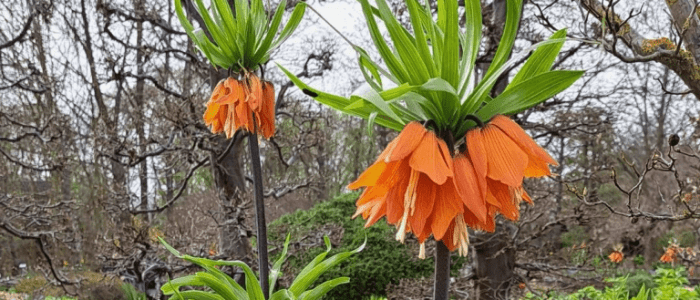Does Fritillaria imperialis like sun or shade?
Information about the Inverted Tulip Flower, The inverted tulip is an endemic plant native to Anatolia, which is very similar to the tulip flower, but consists of four flowers that stand more than one and inverted on a branch. This flower, whose Latin name is “Fritillaria Imperialis”, grows in high areas of 1000 meters and above 1000 meters.
The inverted tulip is a bulbous plant. The bulbs are planted in the fall and bloom in the spring. Tulips are a favorite food for deer and rabbits. It is also an important food source for some insect species. Some information about the inverted tulip:

Appearance: The inverted tulip grows 50 to 60 cm tall and has bell-shaped flowers, similar to the tulip flower. The flowers are usually orange, red or yellow in color and face inverted downwards.
Distribution: The reverse tulip is found worldwide in Turkey, Asian countries, Iran, Afghanistan, Pakistan and the Himalayas.
Symbolism The inverted tulip is considered a symbol of love, affection, humility and sadness. It has an important place in many religions and cultures.
Legends: There are many legends about the inverted tulip. According to one legend, the inverted tulip sprouted from the tears shed by the Virgin Mary, who was very sad after the crucifixion of Jesus Christ.
Use: The inverted tulip is grown as an ornamental plant. The flowers can also be dried and used in arrangements.
Plant Characteristics of Reverse Tulip
Bulb: 7-8 cm, flattened; leaves arranged in tiles. Stem height: 50-100 cm. Leaves: 4-8; bright green; circularly arranged in the upper half of the stem; lanceolate. Flowers: 5-12; bell-shaped. Tepals: 4-4.5 cm; red or orange, sometimes yellow, honeydew-secreting glands at base of tepals, white rounded. Capsule: 1.5-2 cm; winged. Flowering period: March to May. The 60-90 cm height, the interesting flower and the leaves of the terracotta plant make it imposing and showy and give it a noble stance. The flower color, color difference, shape and posture make the plant unique. The vibrant yellow-orange to red colors and shades, the bell-shaped flower and the clusters of bright green leaves scattered on top make it an eye-catcher.
Inverted Tulip Varieties
- Fritillaria Imperialis “Brahms”: Unlike the other varieties, this variety with salmon and pink flowers does not have a scent that discourages rodents and voles.
- Fritillaria Imperialis “Maxima Lutea”: Probably the most popular of the reverse tulip varieties. Its yellow petals make its crown even more unique.
- Fritillaria Imperialis “Rubra Maxima”: It offers a characteristic shade of orange and red, with a caramelized and somewhat roasted appearance. The flowers are shaped like human eyes, surrounded by long female and male stamens. They can reach a size of 100 to 110 centimeters.
- Fritillaria Imperialis “Aurora”: Like the Profiler variety, it has red and orange flowers. This variety, which can reach up to 90 centimeters, is resistant in generations 5a-8b.
- Fritillaria Imperialis “Beethoven”: A dwarf variety that can reach up to approximately 60 centimeters in size. It has cream and orange flowers that develop from a purple base and is particularly sensitive to waterlogged soils.
- Fritillaria Imperialis “Aureomarginata”: With flowers that offer a lighter shade of orange, this variety has green-gold bicolored leaf parts similar to those of the ribbon flower.
- Fritillaria Imperialis “The Premier”: It has flowers with a light orange color, similar to tangerine, with light purple veins on the top. Its size varies between 60-90 centimeters.
- Fritillaria Imperialis “Bach”: Another dwarf variety that can reach approximately 60 centimeters in size. The flower parts are red in color, with orange tones. In addition to keeping rodents and deer away, this variety attracts bees as well as other flower varieties.





